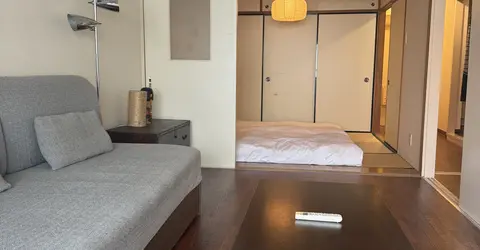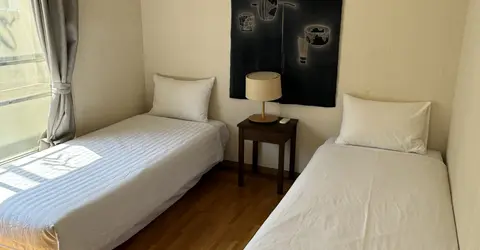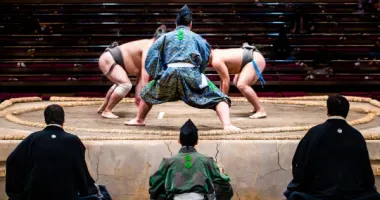Quirky Tokyo Museums
Tokyo's quirky museums: see a listing of the best of several weird and wonderful museums in Tokyo, including the strange Meguro Parasitological Museum and a Sewerage Museum.
- Meguro Parasitological Museum
- Sewerage Museum
- Meiji University Museum
- Tobacco and Salt Museum
- Ryogoku Fireworks Museum
- Asakusa Museum of Sculpture
Tokyo's Quirky Museums 東京の奇妙な博物館
Among Tokyo's many museums several stand out as being somewhat unusual, quirky, even decidedly strange.
See a listing of some of Tokyo's weirdest museums.
 Meguro Parasitological Museum, Meguro, Tokyo
Meguro Parasitological Museum, Meguro, Tokyo
Meguro Parasitological Museum
The Meguro Parasitological Museum in Meguro, Tokyo claims to be very unusual, in fact the only museum of its kind in the world, dedicated to bugs, parasites and other creatures that dependently live in or on other organisms, including humans. Established in 1953, the Meguro Parasitological Museum has two floors of parasite specimens in jars of formaldehyde. They include nematodes, trematodes and malaria parasites. The first floor introduces parasites in general in a variety of creatures including fish, while the second floor has around 300 specimens of human parasites including liver flukes and a 9 meter long tape-worm removed intact from the bowels of an unfortunate patient.
Meguro Parasitological Museum
4-1-1, Shimomeguro, Meguro-ku, Tokyo 153-0064
Tel: 03 6218 2500
Admission: Free
Hours: 10am-5pm; From April 2016, the museum will be closed on Mondays and Tuesdays (however if a national holiday falls on Monday or Tuesday, it will be open that day but closed the next day).
20 minutes' walk from Meguro Station or catch any Tokyo bus, except the Tokyu 黒09, from the West Exit of Meguro Station. Get off at the Otori-Jinja Mae (大鳥神社前) stop.
The nearest railway station to the Meguro Parasitological Museum is Meguro Station on the JR Yamanote Line (8 stops from Tokyo Station), the Namboku Line of the Tokyo subway, the Toei Mita Line and Tokyu Meguro Line.
 Man on the Toilet, Sewerage Museum, Kodaira City, Tokyo
Man on the Toilet, Sewerage Museum, Kodaira City, Tokyo
Sewerage Museum, Kodaira City, Tokyo
The Sewerage Museum, also known in English as the Kodaira Sewerage Center, focuses on the disposal (and cleaning) of used water. As well as a history of the development of waste water treatment in Tokyo, and Kodaira in particular, from the Edo Period to the present day, the Sewerage Museum includes an actual, working wastewater tunnel. The museum's best known exhibit is a sculpture of a man sitting on a toilet, reading a newspaper.
Sewerage Museum
1-25-31 Josui Honcho, Kodaira City, Tokyo
Tel: 042 326 7411
Admission: Free
Hours: Tuesday to Sunday 10 am to 4 pm. If Monday is a holiday, the museum will close the next day.
Closed over New Year's from December 27th to January 5th.
The Sewerage Museum is located very close to the Tamagawa Josui Canal. Take the Seibu Shinjuku Line to Higashi Murayama Station, change to the Seibu Kokubunji Line for the direction Kokubunji, get off at Takanodai Station. Alternatively, take the JR Chuo Line to Kokubunji, change to the Seibu Kokubunji Line for the direction Higashi Murayama, get off at Takanodai Station.
 Iron Maiden, Meiji University Museum, Tokyo
Iron Maiden, Meiji University Museum, Tokyo
Meiji University Museum
The Meiji University Museum in Ochanomizu is a free museum in the basement of the Academy Common building on the university's Surugadai campus in central Tokyo. The Meiji University Museum has a very diverse collection of exhibits ranging from the history of the university itself, to archaeological remains, to a quirky section on Edo Period punishments and instruments of torture. The Criminal Materials Department run by the School of Law focuses on crime, punishment, trial and torture. On display are original and replica devices for catching criminals in the Edo Period, books and wood-block prints demonstrating punishments and several means of execution from Japan and overseas. These include a French guillotine and the Iron Maiden of Nuremberg, plus a gibbet and wooden cross for crucifixion from Japan. Various wooden kosatsuba (notice boards) are also on show. These detailed laws (and punishments for breaking those laws) and where placed at the entrances to towns and villages.
Meiji University Museum
1-1 Kanda-Surugadai, Chiyoda-ku, Tokyo 101-8301
Tel: 03 3296 4448
Admission: Free
Hours: Open 10am-5pm daily including Sundays and national holidays. The museum is closed over the New Year period (12/27-1/7) and Obon in mid-August (8/10-16).
Meiji University Museum is a short 3-minute walk from JR Ochanomizu Station (on the Chuo-Sobu Line), 8 minutes from Jinbocho Station on the Toei Shinjuku Line, Mita Line and Hanzomon Line and 6 minutes from Ochanomizu subway station on the Chiyoda Line.
 © Tobacco and Salt Museum; Salt from around the world
© Tobacco and Salt Museum; Salt from around the world
Tobacco and Salt Museum
The Tobacco and Salt Museum is in Sumida-ku not far from the Tokyo Skytree and is almost free, costing only 100 yen (50 yen for kids) to enter. The museum's quirkiness lies in the juxtaposition of the seemingly unrelated commodities of salt and tobacco - until you realize that they were both government monopolies in Japan. This modern, high-tech facility looks at the various uses of tobacco and salt throughout history. Highlights of the salt section include a 1.4 ton piece of rock salt mined in Poland, a replica of the beautiful rock salt St. Kinga statue in the UNESCO World Heritage-listed Wieliczka Salt Mine in Poland. Salt was historically processed in Japan by boiling sea water and a facility for making salt on the Noto Peninsula can now be seen inside the museum. The tobacco section is dedicated to the origins of smoking, the spread of tobacco and the history of how tobacco came to Japan from the Americas brought by western merchants through Nagasaki, the subsequent history of tobacco in Japan and the rest of the world. There are also exact replicas of an Edo era tobacco shop and another from the period 1975-1985. Cigarette packets, cartons, meerschaum pipes, cigars, rope tobacco, snuff bottles (bienko in Japanese) and other smoking paraphernalia from around the globe are on display along with special exhibitions on a variety of themes including the museums own ukiyo-e collection on the third floor of the museum. One more oddity about this museum is how the health-related exhibits on the salt floor are notably absent on the tobacco floor. Go figure!
Tobacco and Salt Museum
Yokokawa 1-16-3, Sumida-ku, Tokyo, 130-0003
Tel: 03 3622 8801
Admission: 100 yen for adults, 50 yen for students
Hours: 10am to 6pm; Closed Mondays.
Tokyo Skytree Station on the Tobu Skytree Line (8 minutes on foot)
Honjo-azumabashi Station on the Toei Asakusa Line (10 minutes on foot)
Oshiage Station on the Hanzomon Line and Toei Asakusa Line of the Tokyo subway (12 minutes on foot)
Kinshicho Station on the Sobu Line (20 minutes on foot)
 Fireworks Museum, Ryogoku, Tokyo
Fireworks Museum, Ryogoku, Tokyo
Ryogoku Fireworks Museum
Ryogoku Fireworks Museum in the Ryogoku area of Tokyo, close to the Sumida River, the Edo-Tokyo Museum and Eko-in Temple, is a free one-of-a-kind facility dedicated to the history of fireworks in Japan and the many spectacular fireworks festivals held throughout the year. Fireworks were introduced in to Japan in 1613 by John Saris, a compatriot, though by no means friend, of William Adams, both men English traders, working out of Hirado in Nagasaki Prefecture. The Ryogoku Firework Museum exhibits a number of original Japanese cylindrical fireworks, launchers, the happi coats traditionally worn by Japanese pyrotechnicians, newspaper clippings, and posters celebrating the major Japanese fireworks festivals.
Ryogoku Fireworks Museum
2-10-8 Ryogoku, Sumida-ku, Tokyo 130-0026
Tel: 03 5608 6951
Admission: Free
Hours: Irregular: May, June, September, October open Thursday, Friday, Saturday, Sunday. July & August open daily. November-April open Thursday, Friday, Saturday.
JR Ryogoku station (JR Sobu line)
Ryogoku subway station (Toei Oedo line)
 Asakura Museum of Sculpture, Yanaka, Tokyo
Asakura Museum of Sculpture, Yanaka, Tokyo
Asakusa Museum of Sculpture
The Asakusa Museum of Sculpture is a whimsical museum in Tokyo's beautiful Yanaka district that combines art with landscaping. Housed in the spacious, three-story home of the late artist Fumio Asakura (1883-1964), visitors can enjoy Asakura's numerous renditions in bronze of mainly cats and handsome, mostly nude young men in various poses, as well as the authentic grandeur of the old traditional house itself, the artist's Western-style studio, and the elegant beauty of its verdant grounds. There's a goldfish pond, a rooftop garden, and even a human skeleton in the study!
Asakusa Museum of Sculpture
Yanaka 7-18-10, Taito-ku, Tokyo 110-0001
Admission: 500 yen for adults, and 250 yen up to high school student age
Hours: 9:30am to 4:30pm (last admission 4pm) every day except Monday and Friday. However, if Monday or Friday is a public holiday, it remains open on that Monday or Friday and closes the next day (Tuesday or Saturday). Closed December 29 - January 3
3 minutes' walk from JR Nippori Station. Turn left out of the West Exit of Nippori Station, follow the road as it slopes up, take the third street on your left, walk 75 meters, and the Museum is on your left.





























